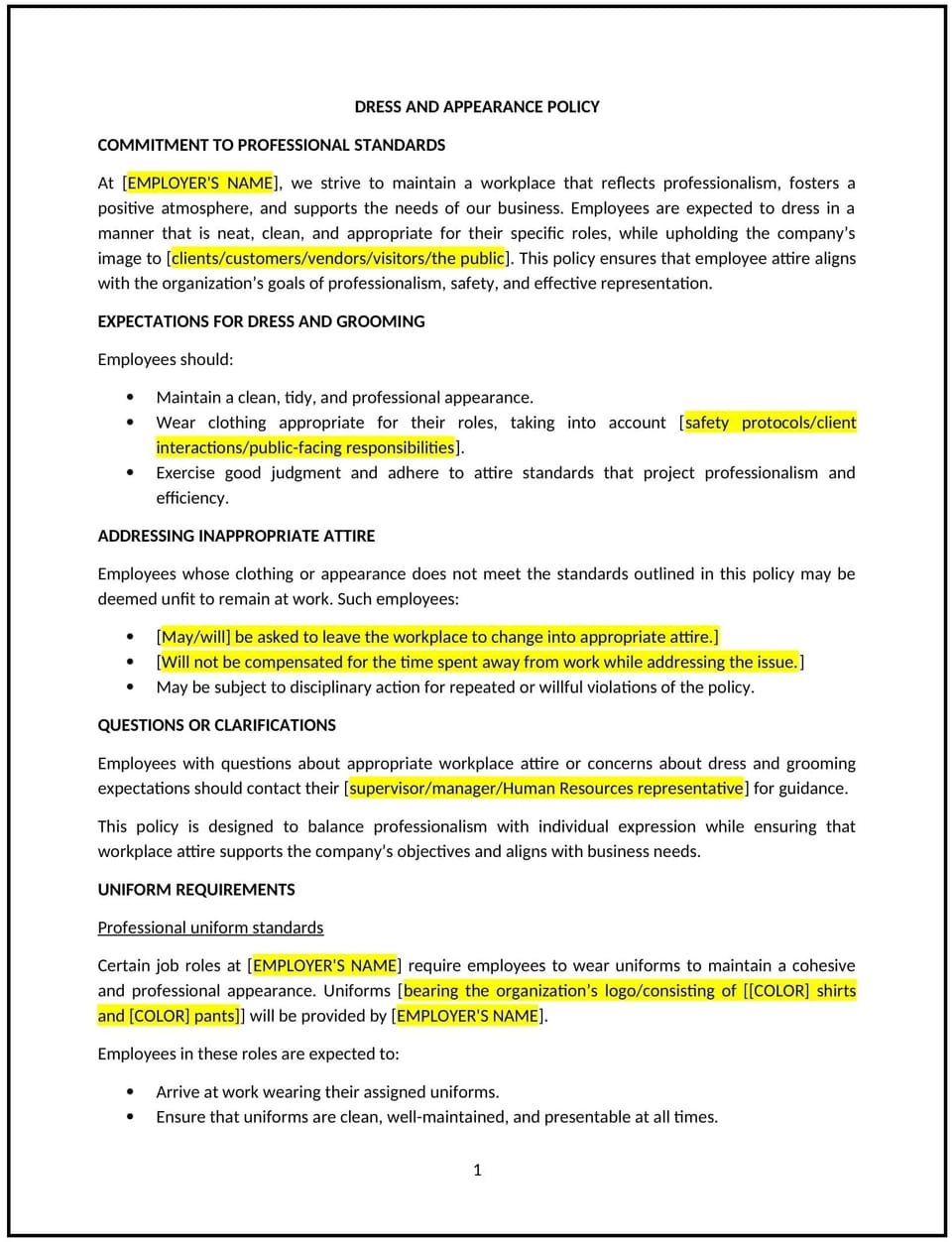Dress and appearance policy (Pennsylvania): Free template

Dress and appearance policy (Pennsylvania)
This dress and appearance policy is designed to help businesses in Pennsylvania establish clear expectations for workplace attire while respecting professional standards and individual expression. Whether managing customer-facing roles, safety-critical industries, or casual office environments, this template provides guidelines for maintaining a consistent and appropriate appearance at work.
By using this template, businesses can promote professionalism, support workplace safety, and reflect their brand image while adhering to Pennsylvania-specific labor considerations.
How to use this dress and appearance policy (Pennsylvania)
- Define acceptable attire: Clearly outline what constitutes appropriate dress for the workplace, such as business casual, uniforms, or industry-specific safety gear.
- Address specific roles: Provide additional guidelines for employees in roles requiring customer interaction, formal attire, or protective clothing.
- Include flexibility for accommodations: Specify how the business will handle requests for dress code accommodations, such as for religious or medical reasons.
- Establish enforcement procedures: Detail how the policy will be applied, including steps for addressing violations in a consistent and respectful manner.
- Reflect Pennsylvania-specific considerations: Tailor the policy to align with local workplace needs, such as seasonal weather variations or industry-specific attire.
Benefits of using a dress and appearance policy (Pennsylvania)
A well-structured dress and appearance policy supports professionalism and workplace harmony. Here's how it helps:
- Promotes professionalism: Ensures employees present a polished and consistent appearance that reflects the business’s values.
- Enhances safety: Provides clear guidelines for attire that meets safety standards, particularly in industries like construction or healthcare.
- Encourages inclusivity: Accommodates individual needs, such as religious or medical considerations, to create a supportive workplace.
- Maintains brand image: Aligns employee appearance with the organization’s branding and customer expectations.
- Addresses local needs: Considers Pennsylvania’s seasonal climate and industry trends in establishing practical dress guidelines.
Tips for using a dress and appearance policy (Pennsylvania)
- Communicate expectations: Share the policy during onboarding and provide examples of acceptable attire to avoid confusion.
- Provide accommodations: Establish a process for employees to request reasonable accommodations related to dress or appearance.
- Train managers: Equip supervisors with the tools to enforce the policy consistently and respectfully.
- Monitor feedback: Regularly seek employee input to ensure the policy remains practical and inclusive.
- Review periodically: Update the policy to reflect changes in Pennsylvania labor laws, workplace practices, or organizational needs.
Q: What types of attire are typically required under this policy?
A: The policy outlines acceptable attire based on the workplace environment, such as business casual, uniforms, or safety-specific gear.
Q: How are accommodations for dress or appearance handled?
A: Employees can request accommodations for religious, medical, or other reasons by following the procedures outlined in the policy.
Q: What steps should businesses take to address violations of this policy?
A: Businesses should handle violations respectfully and consistently, following the enforcement procedures outlined in the policy.
Q: How does this policy balance professionalism and individual expression?
A: The policy ensures employees meet workplace standards while providing flexibility for personal preferences and needs, as long as they align with business requirements.
Q: Are seasonal considerations included in this policy?
A: Yes, the policy includes guidelines for attire during Pennsylvania’s seasonal weather variations, such as options for summer and winter.
This article contains general legal information and does not contain legal advice. Cobrief is not a law firm or a substitute for an attorney or law firm. The law is complex and changes often. For legal advice, please ask a lawyer.


